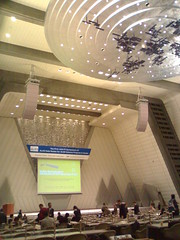
High-fructose corn syrup for sale (Photo credit: Steven Vance)
The fact that America has an obesity epidemic is no secret. Apologists argue that this is a product of the world in which we live. Americans, today, live a more sedentary lifestyle than in the past, and as a consequence, we have become fatter. Of all of the member nations of the Organization for Economic Cooperation and Development (OECD), America has the largest population percentage (30.6%) that is obese. Coming in at 23%, the United Kingdom is the second most obese nation, and interestingly, of all the other OECD countries, it is comparably most similar to America in terms of cultural aspects. Following the sedentary lifestyle argument, it would only follow that the world’s most developed nations would have comparable obesity rates. However, in reality, this is not the case. The G8 countries are the most affluent in the world, yet none have an obesity rate close to that of America. Having already listed the obesity rate of two G8 Nations, now allow me to name the rest: France: 9.4%, Russia: Anywhere between 16.2% and 20 %; Russia does not actively report on obesity)[1], Italy: 8.5%, Germany: 12.9%, Canada:14.3%, and finally Japan: 3.2%.[2]
Despite having very similar levels of living, America’s obesity rate is staggeringly higher. However, it would be factious of me not to say that there is not a correlation between income levels and obesity rates. The OECD has taken note and has released some staggering facts such as, “until 1980, fewer than one in ten people were obese. Since then, rates doubled or tripled and in 19 of 34 OECD countries, the majority of the population is now overweight or obese. OECD projections suggest that more than two out of three people will be overweight or obese in some OECD countries by 2020”1. Nonetheless, the question must be asked: despite obesity being on the rise, why does America appear to have such a huge head start? While a sedentary lifestyle does undoubtedly play a role, there is another dominant factor as well. Your good old Uncle Sam is determining what you are and aren’t eating through laws and taxes.
America was founded as a democracy, but that has not stopped the establishment of kings in this country. The first and most famous king was, of course, King Cotton. The economic power of this cash crop helped propel the economic success of America in a pre-industrialized world. While it is uncomfortable to think that the forging of cotton and slavery together helped establish America on the world stage, it is a reality, and it is our duty as Americans not to shy away from our past. However, our King today started out in a more humble fashion and ascended to the throne over the course of American history. I am, of course, talking about King Corn, present in America at the first landing of settlers and saturating American culture today, quite literally might I add. Agriculture in America is a business that is heavily supported and subsidized by the federal government. While we will be primarily discussing its negative consequences, we must recognize that it was started to help farmers in the Great Depression, and many programs, such as crop insurance, are beneficial. However, this government support has morphed over the years and skewed the market in favor of corn and corn-based products. So how does this all work? It works through the rather bluntly titled Farm Bill:
“The 2008 Farm Bill approved $300 billion in mandatory spending (this figure does not include discretionary spending measures that are approved separately). About two-thirds (67%) of the spending measures were allocated toward nutrition, followed by agricultural subsidies (15%), conservation (9%), and crop insurance (8%). The remaining three percent included credit, rural development, research, forestry, energy, livestock, and horticulture/organic agriculture.”[3]
The Farm Bill is typically renewed every five years, but has yet to be renewed in whole. At the moment, it is a victim of Congressional gridlock, a reexamining of its benefits, and the pull of the corn lobby.

This pie chart details the percentages of the bill from 2008. As you see a majority went towards the Supplemental Nutrition Assistance Program (SNAP), more commonly known as food stamps. We, however, are to focus on the 14% that went to crop subsidies. With regards to the 2008 Bill:
“The [2008] bill [gave] some $4.9 billion a year in automatic payments to growers of [corn and soy] such commodity crops, thus driving down prices for corn, corn-based products and corn-fed meats. Cows that are raised on corn, rather than grass, make meat that is higher in calories and contains more omega-6 fatty acids and fewer omega-3 fatty acids—a dangerous ratio that has been linked to heart disease.
Cheap corn has also become a staple in highly processed foods, from sweetened breakfast cereals to soft drinks, that have been linked to an increase in the rate of type 2 diabetes, a condition that currently affects more than one in 12 American adults. Between 1985 and 2010, the price of beverages sweetened with high-fructose corn syrup dropped 24 percent, and by 2006 American children consumed an extra 130 calories a day from these beverages. Over the same period, the price of fresh fruits and vegetables rose 39 percent. For families on a budget, the price difference can be decisive in their food choices.”[4]
Here are some more numbers to put the effect of corn syrup into perspective:
- Percentage of high fructose corn syrup in Americans’ daily caloric intake: 7
- Percentage of U.S. caloric sweeteners made from high-fructose corn syrup: ~40
- The year that high fructose corn syrup became available in the U.S. food supply: 1967
- Percentage U.S. consumption of high fructose corn syrup rose between 1970 and 1990: 1,000%
- Percentage of obese Americans in 1960-1962: 13.4
- Percentage of obese Americans in 2005-2006: 35.1
- Approximate ratio of obese Americans in 2007-2008: 1 in 3
One could argue that America itself has been the test subject since 1967 concerning the effects of high fructose corn syrup. Actual clinical studies are starting to point in the same direction as well. As stated in a recent study published in the journal, Global Health:
“Researchers compared the average availability of high-fructose corn syrup to rates of diabetes in 43 countries. About half the countries in the study had little or no high-fructose corn syrup in their food supply. In the other 20 countries, high-fructose corn syrup in foods ranged from about a pound a year per person in Germany to about 55 pounds each year per person in the United States. The researchers found that countries using high-fructose corn syrup had rates of diabetes that were about 20% higher than countries that didn’t mix the sweetener into foods. Those differences remained even after researchers took into account data for differences in body size, population, and wealth.”[5]
This all begs the question of what we as the public can do about this. There are a wide variety of answers. Some argue for getting rid of the subsidies altogether or extending them to fruits and vegetables. Both arguments rest on the notion of the even playing field upon which capitalism is built. Let the consumer vote with his/her wallet, and the invisible hand will choose the one that is more beneficial. However, we must recognize that corn has a huge head start in this affair, and as such the two hardly can be deemed to be on even footing. This should be taken into consideration during the debate itself, the debate which is still ongoing. This is still a debate which the public can affect, whether you support the status quo or seek change of any kind. Your voice still can be heard by your Representative and your Senator. Of course this is America, home of the ‘do it myself’ attitude. If you’ve lost faith in the political process in this country, and I think there may be several of you out there, why not break the chain, if only a little, by planting your own garden? Democracy is and should never be a top-down process. If a bill is to become law or if something is to be given preference, it should be initiated at the behest of the people. This helps to ensure that we live green, be green.
By Sean P. Maguire
[1] http://www.oecd.org/health/49716427.pdf
[2] http://www.aneki.com/countries2.php?t=Countries_with_the_Highest_Obesity_Rates&table=table_obesity&places=2=*=*=*=*=*&order=desc&orderby=table_obesity.name&decimals=–1&dependency=independent&number=all&cntdn=asc&r=-373-404&c=&measures=Country–obese%20population%20aged%2015%20and%20over%20(OECD%20Countries)&units=–&file=obesity
[3] http://www.snaptohealth.org/farm-bill-usda/u-s-farm-bill-faq/
[4] http://www.scientificamerican.com/article.cfm?id=fresh-fruit-hold-the-insulin
[5] http://diabetes.webmd.com/news/20121127/high-fructose-corn-syrup-diabetes










